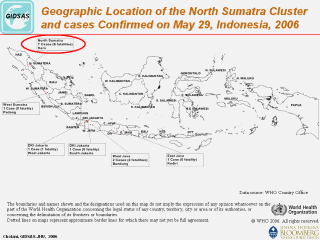| front |1 |2 |3 |4 |5 |6 |7 |8 |9 |10 |11 |12 |13 |14 |15 |16 |17 |18 |19 |20 |21 |22 |23 |24 |25 |26 |27 |28 |29 |30 |31 |32 |33 |34 |35 |36 |37 |review |
 |
On May 23, the World Health Organization (WHO)
acknowledged the likelihood that a large cluster of human cases of H5N1
infections in the northern portion of the Indonesian island of Sumatra is
due to human to human transmission. The cluster comprises 8 individuals of one extended family. On April 27, a 38 year old woman became ill, and then died on May 4. While she was never tested for H5N1 infection, 7 members of her extended family, 3 adult siblings, 2 adolescent sons, a 10 year old nephew and an 18 month old niece subsequently became ill with WHO-confirmed H5N1 infections, and 6 of the 7 have died. The source of the woman’s infection is not known. Three of the infected family members shared a room with her on the night of April 29 while she was actively sick and coughing. The other family members lived nearby. While each of the 7 confirmed cases had prolonged and close contact with an actively sick individual, it appears that they may not have had close contact with the index case, raising the possibility of more than one generation of transmission. Full sequence analysis of 2 viral specimens from this cluster shows no evidence of reassortment or of known mutations thought to increase the likelihood of human to human transmission - the sequences appear to be similar to those of birds from the region last year. 6 new cases and 3 fatalities have been recently reported but none of these cases have been linked to the previous cluster. |